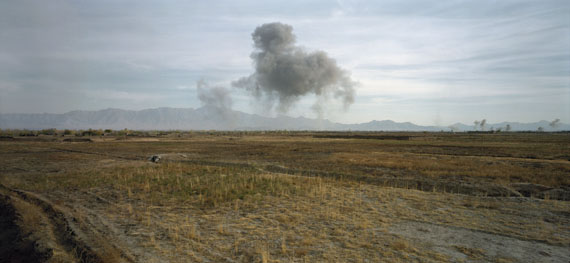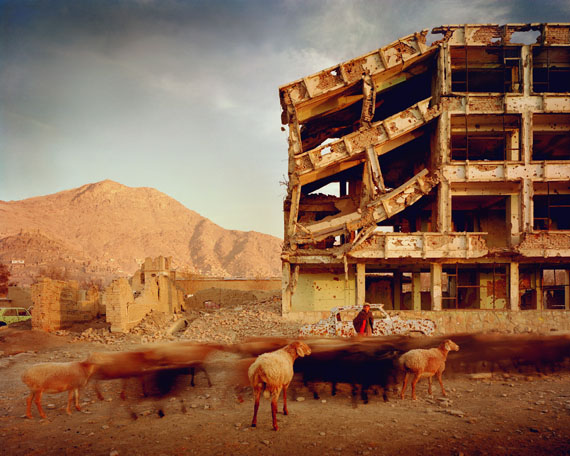
© Courtesy Luc Delahaye & Galerie Nathalie Obadia, Paris/Bruxelles
Conflict, Time, Photography.
Indrė Šerpytytė » Adam Broomberg & Oliver Chanarin » Jules Andrieu » Pierre Antony-Thouret » Nobuyoshi Araki » George N. Barnard » Margaret Bourke-White » Frank Breuer » René Burri » Hermann Claasen » Luc Delahaye » Chloe Dewe Mathews » Ken Domon » Matsumoto Eiichi » Hugo Friedrich Engel » Roger Fenton » Toshio Fukada » Jim Goldberg » Rudolf Herz » Dieter Hinrichs » Kenji Ishiguro » János Kender & Harry Shunk » Kikuji Kawada » Peter Kleu » An-My Lê » Jerzy Lewczynski » Émeric Lhuisset » Agata Madejska » Diana Matar » Don McCullin » Don McCullin » Susan Meiselas » Angela Milden » Simon Norfolk » João Penalva » Richard Peter sen. » Walid Raad (The Atlas Group) » Jo Ractliffe » Albert Renger-Patzsch » Sophie Ristelhueber » Julian Rosefeldt » August Sander » Hrair Sarkissian » Karl Hugo Schmölz » Michael Schmidt » Ursula Schulz-Dornburg » Stephen Shore » Taryn Simon » Josef Stoffels » Shômei Tômatsu » Hiromi Tsuchida » Willy von Heekern » Nick Waplington » Franz Wiese » Jane & Louise Wilson » Sasaki Yuichiro »
Exhibition: 10 Apr – 5 Jul 2015
Thu 9 Apr 19:00

Museum Folkwang
Museumsplatz 1
45128 Essen
+49 (0)201-8845444
info@museum-folkwang.essen.de
www.museum-folkwang.de
Tue-Sun 10-18, Thu + Fri 10-20

© Don McCullin, courtesy Hamiltons Gallery, London.
Conflict, Time, Photography
Exhibition: 10 April – 5 July 2015
"Conflict, Time, Photography" presents the many facets of the artistic portrayal of armed conflicts using the medium of photography. Artists such as Don McCullin, Pierre-Antony-Thouret, Simon Norfolk, Stephen Shore, Michael Schmidt and Taryn Simon have depicted acts of war and their legacy, in photographs taken in the mo-ment of the action, as well as days, months, years, and even decades after the event. This major group exhibition has no intention of serving as a ‘history of war photography’, however. It instead explores the various possibilities and strategies that artists and photographers have adopted to try to come to terms with violent conflict, in the hope of overcoming it. On show are some 200 works ranging from a period of just over 150 years in the history of photography, from 1855 to 2013.
The exhibition has been staged in association with London’s Tate Modern and is startling not just for its content, but also for the order in which the works are hung. The press photographs and artworks study acts of aggression and theatres of war, as well as their visible consequences and social legacy. They are arranged, not by artist or period, but according to how long after the event they were cre-ated; starting with eyewitness photographs taken in the thick of the action, to the works of historical documentarians tracing the conflicts of the 19th century, and on to the commemorative works of the 20th and early 21st century that revisit the scenes of battle decades later.
An impressive highlight in the exhibition is the room dedicated to the London Archive of Modern Conflict. Drawing from its extensive collection of historical photographs, objects, posters, flyers, and manuscripts, the display brings together private snapshots, official propaganda images, historical military equipment, and other objects from the First and Second World War to form an all-enveloping multimedia installation.
The original London show has been expanded by an additional section for the Essen presentation, devoted to press images of the Ruhr region directly after the Second World War. Local and regional photographers such as Willy van Heekern, Albert Renger-Patzsch, and Ruth Hal-lensleben joined the ranks of foreign photojournalists, among them René Burri, and Marga-ret Bourke-White, to portray the devastated cities and their residents in the immediate after-math of the capitulation. Their images not only provide very different insights into the war, they also reflect the differing objectives associated with press photography at the time. At one end of the spectrum the images aimed to capture the suffering of the civilian population in cities turned to rubble, and at the other they were intended as a critical survey of German society, confronted by the consequences of the Nazis’ war policy.
An exhibition presented by Tate Modern, in collaboration with Museum Folkwang, Essen, and the Staatliche Kunstsammlungen Dresden.
With generous support from the Sparkassen-Finanzgruppe, as represented by Sparkasse Essen and the Sparkassen-Kulturfonds.�

This area saw fighting between Hikmetyar and Rabbani and then between Rabbani and the Hazaras, 2003
© Simon Norfolk
Conflict, Time, Photography
Ausstellung: 10. April bis 5. Juli 2015
"Conflict, Time, Photography" präsentiert die vielfältigen Formen der bildnerischen Auseinandersetzung mit kriegerischen Konflikten im Medium der Fotografie. Fotografen und Künstler wie Don McCullin, Pierre Antony-Thouret, Simon Norfolk, Stephen Shore, Michael Schmidt oder Taryn Simon zeigen Kriegshandlungen und deren Nachwirkungen: Fotografien, die im Moment des Geschehens sowie Tage, Monate, Jahre und Jahrzehnte nach dem jeweiligen Ereignis aufgenommen wurden. Die großangelegte Gruppenausstellung will keine Geschichte der Kriegsfotografie oder der Fotografie in Kriegszeiten sein; sie fragt vielmehr nach den Möglichkeiten und Strategien der fotografisch-künstlerischen Bewältigung von Krieg und Gewalt. Gezeigt werden in 13 Räumen rund 125 Werke, insgesamt aber mehr als 800 Exponate aus der Zeit zwischen 1855 bis 2013.
Die Ausstellung – in Kooperation mit der Tate Modern, London – fasziniert durch die überraschende Anordnung ihres Material: Die fotografischen Reportagen und künstlerischen Arbeiten, die Kriegsereignisse und ihre Schauplätze, ihre sichtbaren Folgen und sozialen Nachwirkungen in den Blick nehmen, werden zunächst ausschließlich nach dem zeitlichen Abstand zum Geschehen bemessen und gegliedert: beginnend bei der Augenzeugenschaft der im Frontgebiet anwesenden Fotografen über die Dokumentaristen und Spurensucher des 19. Jahrhunderts bis hin zu den Erinnerungsarbeiten des 20. und frühen 21. Jahrhunderts, die Jahrzehnte später diese Orte aufsuchen.
Eindrucksvoll eingerichtet ist der zentrale Raum Archive of Modern Conflict. Das Londoner Archiv konzipierte aus seinen umfangreichen Sammlungen historischer Fotografien, Objekte, Drucksachen und Manuskripte eine Präsentation, die private Aufnahmen, offizielle Bilder, historische Ausrüstungsgegenstände und weitere Objekte aus den Jahrzehnten des Ersten und Zweiten Weltkriegs zu einer multimedialen Installation zusammenführt.
Für Essen wird die Ausstellung aus London um eine Sektion erweitert, die der Berichterstattung über das Ruhrgebiet unmittelbar nach Ende des Zweiten Weltkriegs gewidmet ist. Lokal und regional ansässige Fotografen wie Willy van Heekern Ruth Hallensleben und Albert Renger-Patzsch, ebenso wie auswärtige Bildjournalisten, unter anderem René Burri und Margaret Bourke-White, haben damals ihren Blick auf die kriegszerstörten Städte und ihre Bewohner gerichtet. Ihre Aufnahmen lassen nicht nur sehr verschiedene Perspektiven erkennen, sondern auch die unter-schiedlichen Zielsetzungen, die mit den fotografischen Bildberichten verbunden waren. Auf der einen Seite der Blick auf die Leiden der Zivilbevölkerung in den zerstörten Städten, auf der anderen Seite eine kritische Bestandsaufnahme der deutschen Gesellschaft, die sich mit den Folgen der NS-Kriegspolitik konfrontiert sah.
Eine Ausstellung der Tate Modern, London in Zusammenarbeit mit dem Museum Folkwang, Essen und den Staatlichen Kunstsammlungen Dresden.
Gefördert durch die Sparkassen-Finanzgruppe, vertreten durch die Sparkasse Essen und den Sparkassen-Kulturfonds des Deutschen Sparkassen- und Giroverbandes.
�

Eine Kamera klagt an, 1949 Bromsilbergelatine, 17 x 22,8 cm Museum Folkwang, Essen
© SLUB Dresden/Deutsche Fotothek, Richard Peter sen.